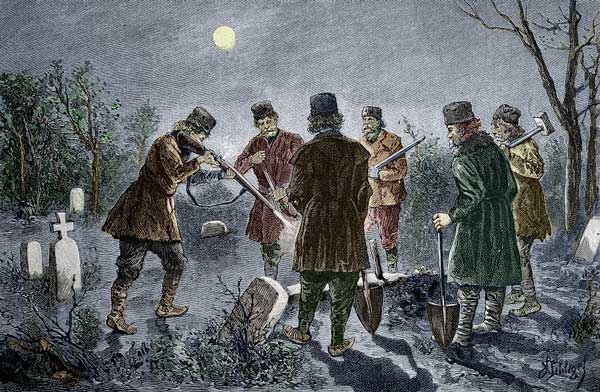
- Legend: Most Famous vampire legend is Count Dracula
- Do Vampires Exist: It is believed they do, going back to ancient Babylonian times
- Name: Derives from the Hungarian word “Vampir”
- A Collection of Vampires is Called: A coven or a clan
- Written Work: Most famous written work is Bram Stoker’s Dracula
- One Thing that Vampires Do Not Have: A reflection
- The Most Well-Known Female Vampire: Countess Elizabeth Bathory, who bathed in the blood of young girls to keep her own vitality.
- History: Vampires Do Exist and Are Much Older than We Think
- History: Vampires Caused Hysteria in the 18th Century
- Culture: Vampires Were Popular on Film and Further Increased Their Legend
- History: Female Vampires Were Blamed for Many Wrongdoings
- Prevention: It Is True that Garlic Can Repel Vampires
- The First Mention of the Name Vampire Came in 1734
- Dolmens Were Used to Stop Vampires Rising
- Vampires Are Connected to the British Royal Family
- To Rid Yourself of a Vampire…Eat a Vampire?
- There Are Rare Medical Conditions that Vampires Suffer From
Vampires Do Exist, and Are Much Older than We Think

Vampire facts tell us that although the first proper mentions of them in literature date to the 18th century, the first true Vampires actually date back to the ancient Babylonians and the year 4000 BC. They were called ekimmu and were believed to be a vengeful or evil spirit who had, upon death, not been buried properly, and thus escaped to torment and suck the life out of people who were still living.
Vampires Caused Hysteria in the 18th Century
So much so, that people actually took to digging up the bodies of dead people to “kill” them again, making sure they could not come back to haunt them. This actually led, in some countries, to laws and statutes being passed to prevent people bringing up bodies and causing them any more harm. However, in some places there were mass beheadings and hangings of people who were presumed or suspected to be Vampires.
Vampires Were Popular on Film and Further Increased Their LEGEND
Vampire Facts show that one of the most notable film Vampires was FW Murnau’s epic silent film Nosferatu, made in 1922, though the first real film depiction was in the 1912 movie The Secrets of House Number 5. Still to this day, the most memorable portrayal of Dracula was by the actor Bela Lugosi, and this, for many, is the defining characterization and the most recognizable image of him.
Female Vampires Were Blamed for Many Wrongdoings

Most notably feeding on the flesh of the living. It was therefore not uncommon for suspected female vampires to be buried with a rock or brick in their mouth to prevent them from coming back to life and eating the flesh of the dead. It was commonly believed during the time of the plague in the 17th century that Vampires would do this, so during this time the practice became even more common.
It Is True that Garlic can Repel Vampires
Well, that is if you do believe they exist, of course. Garlic is rich in a compound called Allicin, which is a known and proven antibiotic, known to repel many different types of germs and viruses. Vampire facts indicate that in folklore, people believed garlic would protect them from Vampire attack. Brides would carry it under their wedding dresses to keep them safe, and sailors believed it would protect them from shipwreck and Vampire attack when they were sailing.
The First Mention of the Name Vampire Came in 1734
The first notable mention of the word Vampire came in the 18th century in a book called Travels of Three English Gentlemen, though to this day, nobody knows who authored the book. However, the term dates back much further than that, possibly to the 17th century Slavic countries, and is believed to be roughly translated from an ancient word meaning witch.
Dolmens Were Used to Stop Vampires Rising
A Dolmen is an ancient stone monument which has been found placed over the graves of many suspected Vampires, particularly in areas in and around Northern Europe. Archaeologists believed they were installed over the graves to stop the evil spirits rising from the body once the Vampire was dead. These monuments looked like stone tables and were often incredibly heavy.
Vampires Are Connected to the British Royal Family

Well, allegedly anyway! It is believed that Prince Charles is distantly related to Count Dracula – otherwise known as Vlad of Walachia (and you might even be more familiar with his other name – Vlad the Impaler), an evil 15th century ruler known for his brutal treatment of people, often skinning them alive. His own name means Son of Dracula and he was murdered in 1476, though his tomb has been located and since found to be totally empty. To this day, nobody knows where his mortal remains lie. The Prince has also admitted this himself too, jokingly confessing that he thinks he “might have a stake in Romania”. Genealogists of note have admitted he might well be right, too.
To Rid Yourself of a Vampire…Eat a Vampire?
Vampire facts suggest that it was commonly believed the only way to rid yourself of a suspected vampire attack was to actually eat or drink the remains of a Vampire. This was done in one of two ways: by turning the ashes of a Vampire into a hot drink to imbibe, or to bake the blood of a dead Vampire into a loaf of bread and eat it. This might not catch on at Subway, though.
There Are Rare Medical Conditions that Vampires Suffer From
…and believe it or not, it once again gives another link to the British Royal Family. A little-known condition called Porphyria (said to not only have affected King George III, but also latterly Princess Margaret) is something that many people who are believed to have been Vampires have suffered from. The illness causes excessive hair growth, intense sensitivity to sunlight and, in some patients, teeth may end up stained a reddish brown color.
Vampire Facts – Facts about Vampires Summary
 Vampires have been said to have been in existence since ancient Babylonian times, though they were known as ekimmu rather than the name we’re commonly familiar with. The first mention of them in literature came in the 18th century, and the first film featuring a prominent Vampire character was released in 1912. The British Royal Family have Vampire connections. It is still believed the best way to protect yourself from a Vampire attack is to eat garlic.
Vampires have been said to have been in existence since ancient Babylonian times, though they were known as ekimmu rather than the name we’re commonly familiar with. The first mention of them in literature came in the 18th century, and the first film featuring a prominent Vampire character was released in 1912. The British Royal Family have Vampire connections. It is still believed the best way to protect yourself from a Vampire attack is to eat garlic.
Was this page helpful?
Our commitment to delivering trustworthy and engaging content is at the heart of what we do. Each fact on our site is contributed by real users like you, bringing a wealth of diverse insights and information. To ensure the highest standards of accuracy and reliability, our dedicated editors meticulously review each submission. This process guarantees that the facts we share are not only fascinating but also credible. Trust in our commitment to quality and authenticity as you explore and learn with us.


